German Two-Seaters in World War One
By Bob Pearson
Although it is the fighter pilots that get all the glamour, it was two-seater reconnaisance and ground attack aircraft that would have an effect on the battle below. The earliest military aircraft were used to search out the enemies position .. the next step was to try and stop the enemy from spying on your own position .. hence fighters which try and shoot down the opposing two-seaters, and fighters which try and stop the enemy from doing so. As fighters improved, so too did the two-seaters .. Here are a few which equipped the German Flieger Abteilung and Schustas.
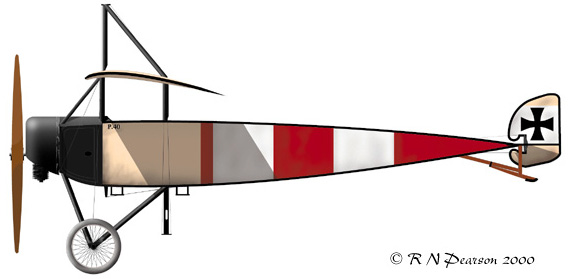
Pfalz Parasol (A.I) P.40
Ltn Ferdinand März / Ltn Wissel
F.Fl.Abt 9b
Toblach Aerodrome, Alpine Front
July 1915
In addition to the regular (ie Prussian) units, Bavaria had its own aviation arm and was forced to purchase its aircraft from Bavarian companies like Pfalz and Otto. The Pfalz Parasol was a license built Morane-Saulnier Type L, which was known to the Prussians as the A.I. In 1915, FFA9b was sent to the Alpine front to help the Austrians in their fight against the Italians. However as Germany and Italy were not at war wih each other yet, their aircraft were given Austrian style red/white markings.
Ltns. Marz and Wissel crashed in this aircraft in July 1915 with little damage to any of them, however Marz was later killed when he crashed shrotly after takeoff on 31 July 1915, the observer survived, but his name is unknown.

AEG C.IV C.6674/16
Schusta 27b
May 1917
Standard markings for AEG aircraft was a sprayed mottle of brown/green or mauve/green on the upper surfaces with either CDL or light blue lower surfaces. This aircraft has been misreported as being at Fl.Abt 224, however it was actually a part of Schusta 27b. The unit marking of a dark chevron shows this. Schusta 27b shared an airfield with FA 224 and their aircraft feature in many of the latter's photo albums. This unit is better known as the one to which the Halberstadt CL.IIs Brunhilde and Thea belonged to.
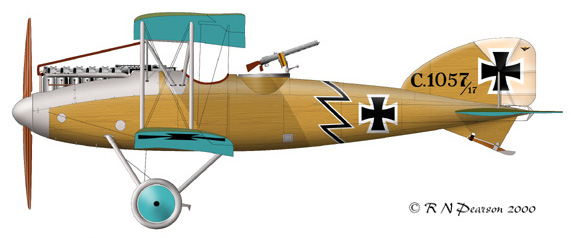
Albatros C.XII C.1057/17
Ltn Geiger / Ltn Rein
Fl.Abt 46
June 1917
Albatros was the largest manufacturer of aircraft in Germany in WW1. their most known designs are the D.III-D.V/Va series, while their two-seaters are best represented by the C.III. The C.XII would seem to be a relatively unknown design - I could only find a handful to profile, and this is the only one with a personal or unit marking.
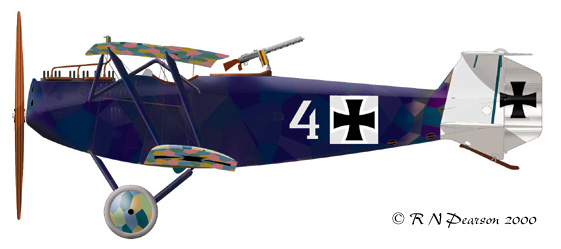
Hannover CL.II
Ltn Faschingbaur / Ltn Stadlbauer
Fl.Abt(A) 292b
March 1918
In addition to reconnaisssance, German two-seaters were used in the ground attack role. Two designs in particular were specially developed for this task - the Halberstadt and the Hannover. As well as ground attack, they were also used by the Fl.Abt as escort fighters. Many an allied pilot thought they were after a single seater only to face an unexpected rear gunner. The Hannover was a particularily tough bird, and was considered to be a hard target to shoot down. The gunner had an excellent field of fire due to the design of the tail and the high fuselage. Typical camouflage for the Hannover was four or five-colour lozenge on all fabric surfaces and large handpainted hexes on the fuselage which got smaller as they approached the rear. The fuselage was then oversprayed with a dark blue paint allowing the hexes to show through.
This is an interesting aircraft in that it is carrying its crosses on white fields - this was quite uncommon in 1918. Faschingbaur and Stadlbauer were killed in a crash of this aircraft on 6 March 1918.
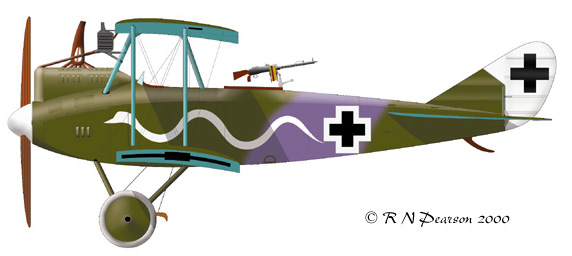
DFW C.V
Ltn Bastian
1 Marine F.Fl.Abt
1918
The DFW C.V was one of the most common of the German two-seaters, and was used by all sorts of units. that seen here was a naval F.Fl.Abt. The colours and pattern are conjectural, although they are known to have be carried by the DFW.
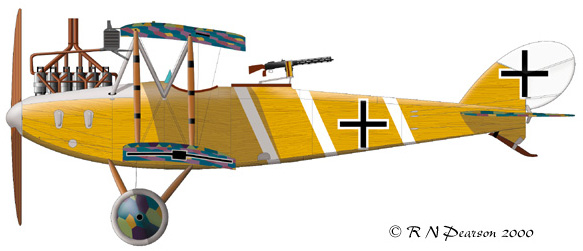
LVG C.V
Unit Unknown
Another widely used, and liked, two-seater was the LVG C.V. Most were finished with varnished fuselage and lozenge wings.
These and 1300 other First World War aircraft can be found on my 'Colours & Markings of the World's Air Forces 1912-1920" CD.




